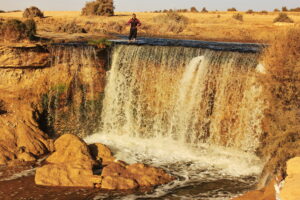Fayoum Oasis
The sites visited in Fayoum depend on the number of days in your tour, see your chosen itinerary for which they will be included. You can visit just for the day on a Real Egypt day tour, camp overnight in the surrounding desert or spend a night in an eco- hotel and spread your visit over two or three days of adventure.
FAYOUM is one of Egypt’s seven beautiful oasis. It is the closest oasis to Cairo, about two hours drive, making it very accessible if Cairo is your base for travelling.
Fayoum offers a diversity of beautiful natural landscapes and geological formations including lakes, sand dunes, valleys, and waterfalls. It has a rich and interesting range of flora and fauna.
This 692 square miles (1114 km2) is a depression that was a lush paradise during prehistoric times. Qarun Lake covers 254 square km (98 square miles) and has a variety of migrating and resident birds.
Fayoum also has beautiful villages and a flourishing crafts and artistic community.
Fayoum has many places of historical interest and is a UNESCO heritage site. Fayoum was favoured during the Middle Kingdom (1991–1790 BC), and 12th Dynasty kings Senwosret II and Amenemhat III built pyramids in the area. In the 19th and early 20th centuries, it was a popular getaway for the Egyptian royal family and Cairo elite.
Fayoum includes two areas declared as protected by the Egyptian Government: Lake Qarun and Wadi Rayan National Parks. It is divided into six administrative centers of which the chief towns are Madinat al-Fayoum, Tamiya, Sinnuris, Ibshawai, Yusuf al Siddiq and Itsa, comprising approximately 157 villages and 1,565 hamlets and with a population of more than 3 million inhabitants.
Fayoum is a vast depression that at its lowest level contains a great lake called Birkat Qarun (Lake Qaroun). This depression receives water from a branch of the Nile that was made into a canal in ancient times, now called Bahr Joussef. This splits up into a dense network of secondary canals. Fayoum is usually referred to as an oasis, but it differs from other oases as it receives water directly from the Nile.
In the 1960s, Egyptian authorities created three lakes in the Wadi Rayan depression, southwest of Lake Qarun, to hold excess water from agricultural drainage. This was intended to be the first step in an ambitious land-reclamation project, though not everything went to plan when the water started to become increasingly brackish. On the positive side, these man-made lakes became particularly conducive to large colonies of birds, leading to the entire depression being administered as a national park.
Name and Etymology
Fayoum had several different names through the ages. In ancient Egypt in the Old Kingdom it was called “Shedet” in reference to the lake, and in the Middle Kingdom it was called “Ta-She” meaning (The land of the Lake). The modern name of the city comes from Coptic “Pa-Ym” – payom – meaning the Sea or the Lake, which in turn comes from late Egyptian “Pa Ym” of the same meaning, a reference to the nearby Lake Moeris. It was called Al Fayoum after the Arab conquest of Egypt – land of the lake.
Climate:
Fayoum enjoys a hot dry climate with rare rain in the Winter, the temperature ranging in the Winter between highs of 11 to 17 and lows of 4 to 10 degrees in January, and the average annual rainfall is around 17 mm.
“Cool are the dawns; tall are the trees; many are the fruits; little are the rains”, el Nabulsi wrote 750 years ago.
Fayoum is best visited using a 4×4 car as the road is uneven and you have to navigate desert sands to reach attractions. Fayoum is an all year round attraction but to enjoy the best weather and your time more we advise:
BEST TIME TO VISIT
- Bird watching: during Winter to observe the bird migration.
- Hiking, trekking and sand-boarding: October through May, as the weather can be very hot in the desert during Summer.
- Chilling out near the lakes: all year round.
- Fishing: September through July.
- Sandboarding: all year round. The most famous sand boarding spot is Qoussour El-Arab.
Places visited may include:
Ruins of Abu Lifa ancient monastery, the ancient Pharaonic road, the Petrified Forest, the rock formations of El Faras valley and its quarry.
Fayoum lake, Qasr El Sagha temple and Dime Al Sebaa, ancient Greek city ruins, overlooking Fayoum lake.
There are several bodies of water including El Rayan Lake. West Qarun Lake, which is also worth visiting for its abundance of birds, and the waterfalls, with opportunities to swim or for sandboarding.
The Water Wheels of Fayoum are a unique attraction. Large wooden wheels invented by Archimedes in the Ancient Library of Alexandria more than 2000 years ago were used to irrigate the region. There are around 200 of these water-powered wheels throughout Fayoum, though they are not found elsewhere in Egypt.

